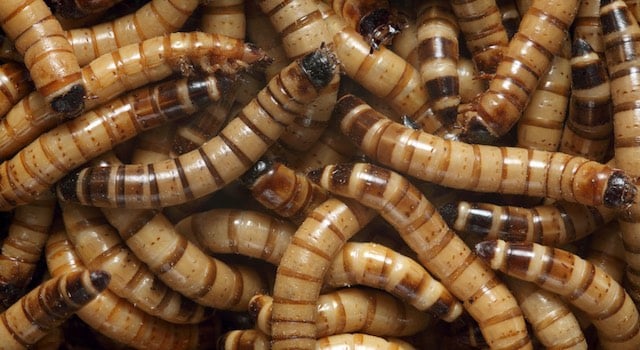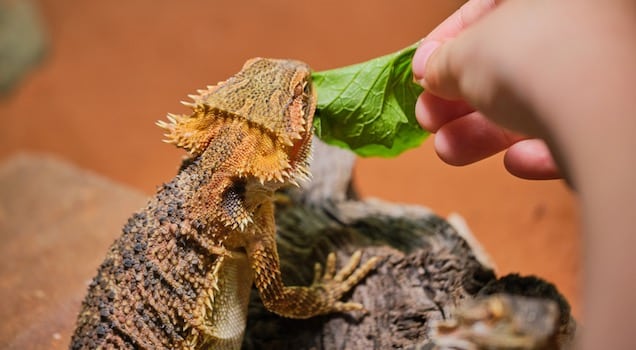
Introduction to Superworms for Bearded Dragons
Bearded dragons are semi-arboreal lizards native to Australia. They are one of the most popular pet reptiles thanks to their friendly temperaments and low-maintenance care needs. They also happen to be one of the easiest reptiles to feed in captivity, and they aren’t very fussy about their diet.
However, it’s still important to feed them the appropriate diet consisting of feeder insects, vegetables, fruits, and dietary supplements. When it comes to feeder insects, superworms are a great alternative to crickets and roaches. Not only are they nutritious, but they are super tasty, too, and most bearded dragons enjoy eating them.
This article will discuss superworms as potential feeder insects and how you can incorporate them as part of a healthy bearded dragon’s diet.
Understanding Superworms for Bearded Dragons
What are Superworms?
Superworms are the larvae of a type of darkling beetle known as Zophobas morio. They are often confused for mealworms, which are another popular feeder insect for reptiles. However, they are much larger, with an average length of 1.7 to 2.25. Their bodies are primarily yellow with darker markings at the end, whereas mealworms are almost entirely yellow.
Nutritional Value
- Protein: 20%
- Fat: 14 – 18%
- Fiber: 3%
- Calcium-to-phosphorus ratio: 1:6.9
Superworms are a great source of protein for bearded dragons at approximately 20%. Bearded dragons need protein for growth, energy, and to maintain muscle mass. These worms are low in fiber, which is ideal because excess fiber in their diet can be difficult to digest. Moderate levels of fiber are still necessary for gut and digestive health, but leafy green vegetables offer more digestible fiber than most feeder insects.
They have a very high-fat content of up to 18%, which can cause excessive weight gain if they are not fed in moderation. This makes them a good source of energy but better as a treat rather than a staple protein source for bearded dragons. This is especially true for obese bearded dragons who shouldn’t have fatty foods in their diet to help manage their weight.
Superworms are also a valuable source of essential vitamins and minerals like iron, vitamin A, calcium, and phosphorus. However, they have a terrible calcium-to-phosphorus ratio because they contain a small amount of calcium and a lot of phosphorus.
For comparison, the ideal calcium-to-phosphorus ratio for bearded dragons is 1:2. Calcium and phosphorus support healthy bones and development, especially in growing bearded dragons.
Buying and Storing Superworms for Bearded Dragons
Only commercial superworms are safe for bearded dragons, and they can be found at most pet stores in-store or online. You can raise these worms in a container with small air holes for ventilation. This could be converted from an old container you have lying around or a medium-sized reptile carrier.
They should be stored at temperatures between 75° to 80° Fahrenheit and kept on a substrate like wheat germ, bran, or oats. You ideally want to house superworms in the larval or pupa stage together to prevent them from maturing into beetles. They don’t mature if they are surrounded by each other, so it isn’t necessary to house them in separate containers.
Feeding Superworms to Bearded Dragons
Feeding Schedule
Only adult bearded dragons can safely eat superworms. They are not recommended for hatchling or juvenile bearded dragons under 12 months of age due to the risk of choking or gut impaction.
Superworms are too big for young bearded dragons to safely swallow, putting them at risk of choking. Also, these worms have thick exoskeletons and are high in chitin, which young bearded dragons struggle to digest, potentially leading to gut impaction.
Adult bearded dragons can snack on 2 to 4 super worms once or twice a week in addition to their main diet, which should consist of vegetables, fruits, and other feeder insects.
Preparing Superworms for Bearded Dragons
As with any feeder insect, superworms must be gut-loaded at least 6 to 24 hours prior to being fed to bearded dragons. They should be gut-loaded with a commercial diet and a rotation of fresh fruits and veggies.
Commercial gut-loading diets contain high traces of essential vitamins and minerals that boost the worm’s nutritional value. These nutrients get passed to bearded dragons once they are eaten. Only offer fruits and vegetables that are safe for bearded dragons, like collard greens, spinach, strawberries, and cruciferous vegetables.
Superworms should be dusted with a calcium and vitamin D3 supplement before being fed to bearded dragons. This is because they contain very low amounts of calcium and too much phosphorus, so supplements help to balance these minerals ratio.
Health Considerations of Superworms for Bearded Dragons
Potential Risks
Superworms have a higher fat content compared to most feeder insects, such as crickets, dubia roaches, and mealworms. Bearded dragons don’t need much fatty foods in their diet because it can contribute to weight gain and obesity.
It’s not healthy for bearded dragons to be obese because it puts stress on their joints and organs or puts them at risk of developing health issues like fatty liver disease. It’s better to offer super worms as an occasional treat rather than a staple protein source.
Although parasites are a potential concern with feeder insects, it’s unlikely that superworms from a pet store have them. Wild-caught superworms have the highest risk of transferring harmful parasites to your bearded dragon, hence why they aren’t safe to feed.
Signs of Overfeeding
Here are a few potential signs to look out for that could indicate you are overfeeding super worms to your bearded dragon:
- Difficulty moving around
- Bloated appearance
- Lethargy
- Lack of appetite
Your bearded dragon should be taken to an exotic veterinarian if you notice any of the above signs. It’s easier to avoid overfeeding your reptile rather than treating their excessive weight gain. Adult bearded dragons generally weigh between 300 to 500 grams, but this varies depending on their subspecies and overall size. They shouldn’t eat more than 4 super worms twice a week, as this would be considered overfeeding.
Tips for Success
Variety in Diet
Bearded dragons need a varied diet and shouldn’t solely rely on superworms for all their nutritional needs. It also keeps their diet interesting and encourages a healthy appetite. They need live insects for protein and amino acids, and vegetables and fruits for vitamins, fiber, and antioxidants.
Superworms don’t contain the right balance of nutrients bearded dragons need, which puts them at risk of nutritional deficiencies and malnutrition if they are fed alone. That’s why a varied diet consisting of at least three different feeder insects is recommended. For example, you can offer super worms as a weekly treat and dubia roaches and crickets as a staple protein source.
Monitoring and Observation
It’s important to closely monitor your bearded dragon’s appetite and adjust their portion of insects and plant-based foods accordingly. Remember, superworms are high in protein and fat, which can make your bearded dragon feel full for longer. This can discourage them from eating the rest of their food and lead to nutritional imbalances over time. It’s a good idea to feed fewer superworms if this is the case to encourage a healthier appetite.
FAQ About Superworms for Bearded Dragons
Can superworms be fed to baby bearded dragons?
No, baby bearded dragons should never eat superworms due to the risk of gut impaction or choking. Bearded dragons must only eat foods smaller than the space between their eyes, and most superworms are larger than this. These worms also have thick exoskeletons that contain a lot of chitin, which is harmful to baby bearded dragons’ gut and digestive health.
How to encourage a picky eater to consume superworms?
Most bearded dragons love the taste of super worms and will happily eat them. In fact, some owners use these worms to encourage picky eaters to eat more plant-based foods. If your bearded dragon is particularly fussy, you can entice them to eat superworms by mixing them with one of their favorite foods. This could be a tasty fruit or even another type of feeder insect.
Are there alternatives to superworms for variety?
Superworms aren’t a healthy staple insect for bearded dragons, so they should be fed along with other feeder insects. Some of the most readily available insects, like dubia roaches, crickets, and mealworms, are great alternatives to superworms and can increase the variety in your bearded dragon’s diet.
Conclusion
Superworms can be a nutritious treat for bearded dragons, but they should be fed in moderation. They are high in protein, which is beneficial for growth and energy. However, they are also high in fat, which can contribute to excessive weight gain. They shouldn’t replace staple foods like crickets and dubia roaches, which have a better nutritional value. Always ensure your bearded dragon is fed a balanced diet of insects and plant-based foods to keep them happy and thriving.



